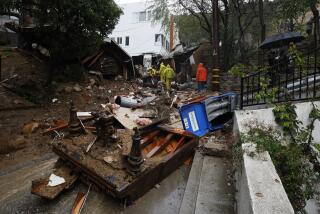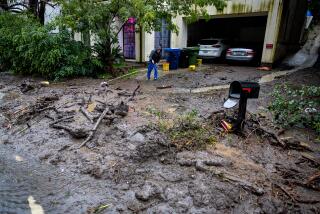Officials: Typhoon Haiyan death toll may soar to 10,000 in Philippines
TACLOBAN, Philippines — The death toll from one of the strongest storms on record that ravaged the central Philippine city of Tacloban could reach 10,000 people, officials said after the extent of massive devastation became apparent and horrified residents spoke of storm surges as high as trees.
Regional police chief Elmer Soria said he was briefed by Leyte provincial Gov. Dominic Petilla late Saturday and told there were about 10,000 deaths in the province, mostly by drowning and from collapsed buildings. The governor’s figure was based on reports from village officials in areas where Typhoon Haiyan slammed Friday.
Tacloban city administrator Tecson Lim said that the death toll in the city alone “could go up to 10,000.” Tacloban is the Leyte provincial capital of 200,000 people and the biggest city on Leyte Island.
PHOTOS: Typhoon Haiyan slams Philippines
About 300 to 400 bodies have already been recovered, Lim said. A mass burial was planned Sunday in Palo town near Tacloban.
The typhoon barreled through six central Philippine islands Friday, wiping away buildings and leveling seaside homes with ferocious winds of 147 mph and gusts of 170 mph. By those measurements, Haiyan would be comparable to a strong Category 4 hurricane in the U.S., and nearly in the top category, a 5.
It weakened Sunday to 101 mph with stronger gusts as it approached central and northern Vietnam where authorities evacuated more than 500,000 people.
“The rescue operation is ongoing. We expect a very high number of fatalities as well as injured,” Interior Secretary Mar Roxas said after visiting Tacloban on Saturday. “All systems, all vestiges of modern living — communications, power, water — all are down. Media is down, so there is no way to communicate with the people in a mass sort of way.”
President Benigno Aquino III said the casualties “will be substantially more” than the official count of 151 — but gave no figure or estimate. He said the government’s priority was to restore power and communications in isolated areas to allow for the delivery of relief and medical assistance to victims.
The U.S. and other governments and agencies were mounting a major relief effort “because of the magnitude of the disaster,” said Philippine Red Cross chairman Richard Gordon.
Even by the standards of the Philippines, which is buffeted by many natural calamities — about 20 typhoons a year, earthquakes and volcanic eruptions — the latest disaster shocked the impoverished nation of 96 million people.
The airport in Tacloban, about 360 miles southeast of Manila, looked like a muddy wasteland of debris, with crumpled tin roofs and upturned cars. The airport tower’s glass windows were shattered, and air force helicopters were busy flying in and out at the start of relief operations.
“The devastation is, I don’t have the words for it,” Roxas said. “It’s really horrific. It’s a great human tragedy.”
ALSO:
Outspoken mayor from Mexico’s Michoacan state found dead
New Pentagon report paints mixed picture of Afghanistan security
Toronto Mayor Rob Ford loses radio show, calls mount for his exit
More to Read
Start your day right
Sign up for Essential California for news, features and recommendations from the L.A. Times and beyond in your inbox six days a week.
You may occasionally receive promotional content from the Los Angeles Times.






